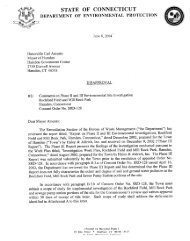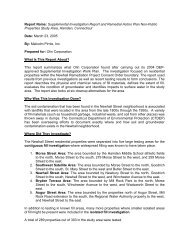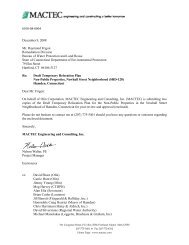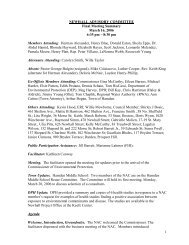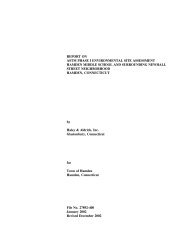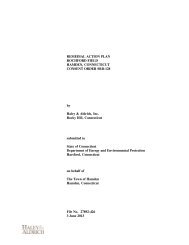Main Report - Newhall Remediation Project
Main Report - Newhall Remediation Project
Main Report - Newhall Remediation Project
- No tags were found...
You also want an ePaper? Increase the reach of your titles
YUMPU automatically turns print PDFs into web optimized ePapers that Google loves.
QVHD Lead Exposure Follow-Up ActivitiesCT DEP referred a number of homes to the QVHD for lead exposure follow-up activities. Thehomes referred for follow up were those homes with elevated lead in surface soil, where youngchildren reside (or visit often), that were not scheduled to receive an EPA immediate soilremoval action. In some cases, an EPA soil removal action was not possible because the elevatedlead in soil was from lead paint, not landfill waste materials. In other cases, the lead elevationwas not high enough to trigger immediate EPA action. Lastly, some homes were discoveredthrough the CT DEP supplemental soil-sampling program after EPA had already completed itssoil removal activities in Hamden.QVHD follow-up actions for elevated lead in soil varied depending on the specifics of thesituation. Activities they conducted included the following.• Providing educational materials to residents about reducing exposure to lead paint in soil.• Providing educational materials to residents about health impacts to adults and childrenfrom exposure to lead.• Conducting home visits to observe the condition of the backyard and suggesting ways toreduce soil exposure (such as mulching bare soil).QVHD Database Search for Elevated Blood Lead Levels in ChildrenTo learn about potential elevated blood lead levels in children residing in the <strong>Newhall</strong> Streetneighborhood, the QVHD performed a manual search of all QVHD files in the <strong>Newhall</strong> Streetarea for elevated blood lead levels. The QVHD found three children with elevated blood leadwho resided in the <strong>Newhall</strong> Street neighborhood since 1978 (when record keeping began). Twoof these children had been relocated from another town into the <strong>Newhall</strong> Street neighborhoodbecause of elevated blood lead levels they had received while living in another town. These twochildren had continual decreases in their blood lead levels while in residence in the <strong>Newhall</strong>Street neighborhood. Peeling paint with toxic levels of lead was the known risk factor for thethird child. CT DPH recognizes that this search would not identify a child with elevated bloodlead who may frequently visit a grandparent or other relative but not reside in the neighborhood.QVHD Community Health Concerns SurveyDuring May and June 2001, staff from the QVHD collected health information from theneighborhood using a community concerns interview form (see Attachment C). QVHD staffvisited 125 homes in the <strong>Newhall</strong> Street neighborhood. In some homes, information wascollected through a personal interview with the resident. In other cases, the resident completedthe survey form themselves. Each of the 125 targeted homes were visited as many as threedifferent occasions if an occupant was not found at home. After the third attempt, an interviewform was left at the residence. The survey was intended to collect information (for qualitativeevaluation) about health symptoms and health concerns among residents living in the area knownto have landfill waste present. Completed survey forms were received from 55 of the 125targeted homes.7



